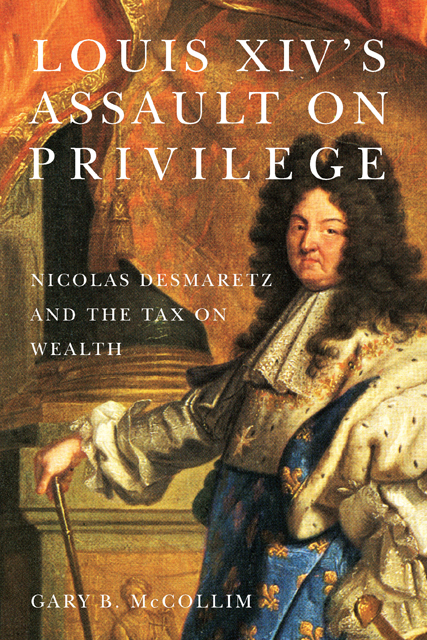Book contents
- Frontmatter
- Dedication
- Contents
- List of Illustrations
- Preface
- List of Abbreviations
- Introduction
- 1 The Fiscal System under Louis XIV
- 2 The Rise of the Administrative Monarchy
- 3 Nicolas Desmaretz and Company
- 4 Handling Ideas for Reform
- 5 The Establishment of the Dixième
- 6 After the Dixième
- Conclusion
- Appendix 1 The Conseil d’en haut, or the Council of Ministers
- Appendix 2 Members of the Royal Council of Finances under Louis XIV
- Appendix 3 Controllers General, Directors, and Intendants of Finances
- Appendix 4 Glossary of Terms
- Notes
- Bibliography
- Index
1 - The Fiscal System under Louis XIV
Published online by Cambridge University Press: 14 February 2023
- Frontmatter
- Dedication
- Contents
- List of Illustrations
- Preface
- List of Abbreviations
- Introduction
- 1 The Fiscal System under Louis XIV
- 2 The Rise of the Administrative Monarchy
- 3 Nicolas Desmaretz and Company
- 4 Handling Ideas for Reform
- 5 The Establishment of the Dixième
- 6 After the Dixième
- Conclusion
- Appendix 1 The Conseil d’en haut, or the Council of Ministers
- Appendix 2 Members of the Royal Council of Finances under Louis XIV
- Appendix 3 Controllers General, Directors, and Intendants of Finances
- Appendix 4 Glossary of Terms
- Notes
- Bibliography
- Index
Summary
Governments depend on credit to survive. One kind of credit is the short-term loan that modern governments make to themselves. In other words, the government spends money in a steady, regular way that has nothing to do with the pace of revenue collection to pay those bills. Old Regime France could not lend money to itself. Instead, it borrowed money from financiers who were employed either as contractors or officeholders to collect taxes and send the revenues to the state. All of these revenue collectors employed similar methods for paying the state while collecting its revenues.
One way of understanding French royal finances is to know how a revenue farm operated. In France, revenue farming appeared at a time when property ownership meant exercising civil authority. When kings were living off their domains, they did not exactly administer the properties. They leased their property to a third party, who promised to pay them a set lease price in monthly, quarterly, or annual installments for a given period of time.
In the Middle Ages, property meant either land or certain rights, or both. For instance, a landholder might also hold the right of justice over the residents of his land. He might also have a toll bridge or a watermill or some other revenue-producing rights on the same piece of land. If he was a great, landed lord, he might have several estates with adjoined rights. Finding them too troublesome to administer directly, he might have leased them, separately or together, to the highest bidder, who promised to pay the lease price regularly. The lord was only concerned with his revenue from this “farm” and took little interest in its daily operation. The farmer who administered the property replaced the lord and enjoyed all the privileges of the actual lord in his absence. The farmer was gambling on profiting from the property by squeezing each and every right for every sol he could get, and by hoping for a good harvest. The proprietor was relieved of the everyday worries of running his property in return for a steady income. All of this, of course, appeared at the stage of Europe’s economic development when these rights and dues could be traded for money.
- Type
- Chapter
- Information
- Louis XIV's Assault on PrivilegeNicolas Desmaretz and the Tax on Wealth, pp. 14 - 49Publisher: Boydell & BrewerPrint publication year: 2012

